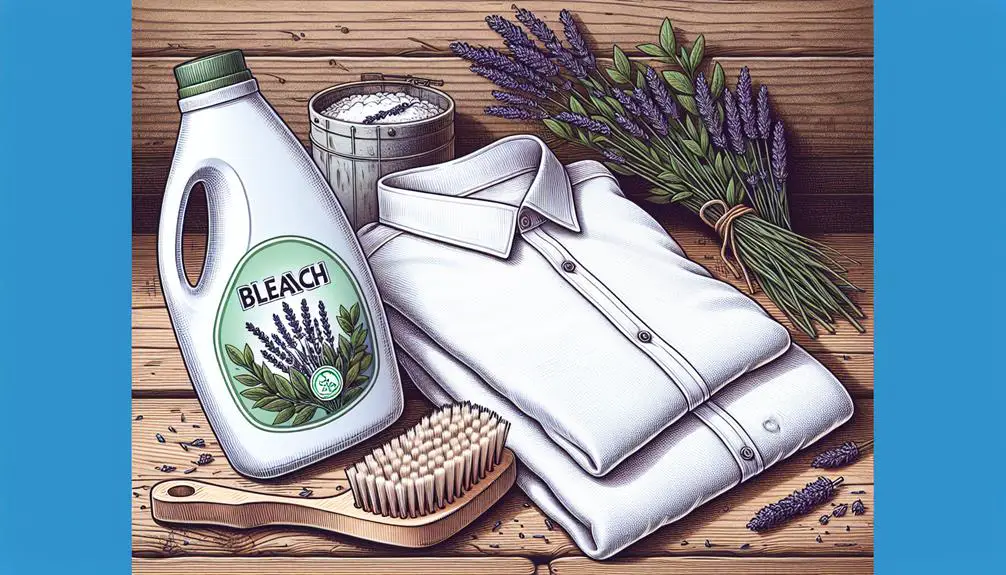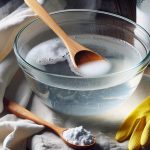I've always been cautious about bleaching linen because I know it's a bit delicate. Sure, you can do it, but it's not as straightforward as tossing it in with some chlorine bleach. I've found that gentler alternatives like hydrogen peroxide or lemon juice can work wonders without ruining the fabric. Now, I'm curious about the best way to tackle this without ending up with damaged linen. I've gathered some steps and tips that promise to keep those linens bright and beautiful. Stick around, and I'll share how to do this safely, avoiding common pitfalls that could lead to disaster.
Table of Contents
Key Takeaways
- Linen can be bleached using safer alternatives like vinegar, baking soda, or oxygen bleach to prevent damage.
- Chlorine bleach is harsh on linen fibers and may weaken or discolor the fabric.
- Natural bleaching agents like lemon juice and hydrogen peroxide are gentler and environmentally friendly options.
- Pre-soaking linen in cold water and carefully following a step-by-step bleaching guide ensures effective stain removal without harm.
- Always rinse linen thoroughly after bleaching and air dry to maintain fabric quality and prevent residue build-up.
Understanding Linen Bleaching
When it comes to freshening up my linen, knowing the right way to bleach it can make a huge difference. I've learned that not all bleach methods are created equal, especially when dealing with linen, a fabric that demands a gentle touch. Chlorine bleach is a big no-no for my delicate linen pieces, as it's just too harsh and can damage the natural fibers, leaving them weaker or even discolored.
Instead, I've turned to safer alternatives like baking soda, vinegar, oxygen bleach, hydrogen peroxide, and lemon juice. These natural and chemical alternatives have been my go-to solutions for removing those stubborn stains or the yellow and grey spots that sometimes appear on my white linen over time.
I've experimented with various methods, such as soaking the linen in any of these solutions, and found them to be effective in tackling different types of stains without the risk of ruining my fabrics. This approach has been a game-changer for me, especially when my linen shows signs of discoloration or when those persistent stains refuse to budge after a regular wash. It's all about choosing the right bleach alternative and method to keep my linen looking pristine.
Chemical Versus Natural Methods
Deciding between chemical and natural bleaching methods for my linen has really shown me the pros and cons of each approach. At first, I was all in for the quick results that chlorine bleach promised. But learning about how harsh it can be on my delicate linen fibers made me think twice. It's not just about getting my white linen to sparkle; it's also about keeping it in top shape for as long as possible.
On the flip side, natural methods using vinegar, lemon juice, baking soda, and even hydrogen peroxide seemed like a gentler way to tackle those stubborn stains. They're not only kinder to the fabric but also to the environment. I've found that mixing water with a bit of vinegar or lemon juice can brighten up my linens without the fear of damaging them. Plus, using these eco-friendly alternatives means I'm not contributing to harsh chemical runoff.
The difference is clear: natural methods are the way to go for maintaining the quality and longevity of my linens while still getting them as white as I want. It's a win-win situation.
Step-by-Step Bleaching Guide
After weighing the pros and cons of chemical versus natural bleaching, let's get into how you can actually bleach your linen step by step.
First, I always pre-soak my linen in a bucket of cold water. It's like giving it a little prep talk before the main event. This step helps loosen up any dirt or grime, making the actual bleaching process more effective.
Next up, I check for any stubborn stains. If I spot anything, I know those areas might need a bit more TLC during the bleaching process. I then whip up my bleaching solution. Instead of going for chlorine bleach, I opt for an environmentally friendly alternative. I mix a powdered bleach alternative with a mild detergent and water. It's my go-to because it's less harsh on the fabric.
After soaking the linen in this solution, I make sure to rinse it thoroughly. Gotta get all that bleach out to ensure the fabric's quality stays top-notch. Then, I inspect the linen. If it needs more love, I'm ready to repeat the process.
Common Bleaching Mistakes
Let's dive into the common mistakes folks make when bleaching linen, so you don't have to learn the hard way. First off, using too much chlorine bleach is a big no-no. It's not just about getting your linen whiter than white; you're actually risking weakening and damaging those delicate fibers. Trust me, you don't want your favorite shirt to start falling apart.
Another mistake isn't diluting bleach properly. I've seen it firsthand, and the result isn't pretty—think uneven patches and a fabric that's more brittle than before. And whatever you do, don't mix bleach with other chemicals. I learned the hard way that this can lead to toxic fumes and even more harm to your linen.
I've also seen folks apply undiluted bleach directly onto linen, only to be met with yellowing and weakened fabric. It's heartbreaking, really. Lastly, always check the care label and do a patch test before going all in. Ignoring these can lead to irreversible damage, and nobody wants that. Trust me, paying attention to these details can save your linen from discoloration and deterioration.
Maintenance After Bleaching
So, you've bleached your linen; now it's crucial to rinse it thoroughly to get rid of any leftover bleach and cleaning stuff. You don't want any of that bleach residue hanging around, trust me. Next up, let's talk about getting that linen dry. You're gonna want to air dry it, but make sure you're doing this in a well-ventilated area. Direct sunlight or too much heat can do more harm than good, alright?
After it's all dry, give it a good once-over. Inspect the fabric to see if those pesky stains are truly gone. If not, you might need to consider a gentle stain remover as a follow-up.
Here's a quick table to help you remember the key steps for post-bleaching maintenance:
| Step | Key Point |
|---|---|
| Rinse | Remove bleach and cleaners |
| Air Dry | In a ventilated area |
| Inspect | Check for remaining stains |
Lastly, when you're storing your freshly bleached linen, follow those care label instructions closely. It's all about preserving that quality, folks. And remember, post-bleaching maintenance is all about keeping your linen in top shape, so always store it properly and follow care instructions to a T.
Frequently Asked Questions
How Do You Bleach 100% Linen?
I'd use natural methods like lemon juice or baking soda to bleach my 100% linen. Oxygen bleach's a safe alternative too. I always avoid chlorine bleach and do a patch test first to avoid damage.
Can You Bleach Linen to Make It Lighter?
I've found that you can definitely make linen lighter by bleaching it. I use natural methods like lemon juice or baking soda instead of harsh chemicals, which work great and keep the fabric safe.
How Do You Get Stains Out of Linen?
To get stains out of linen, I soak it in water mixed with natural agents like vinegar or lemon juice. For tougher stains, I pre-treat with hydrogen peroxide. I avoid chlorine bleach to prevent damage.
Which Fabrics Can Be Bleached?
I've found that many fabrics can be bleached, but it really depends on their material. Cotton and linen handle it well, especially with oxygen-based bleaches, but silk and wool are more sensitive and require care.
- How Does Ring Spun Cotton Affect Garment Fit and Shape Retention? - August 13, 2024
- What Are the Challenges in Producing Ring Spun Cotton? - August 13, 2024
- Is Ring Spun Cotton Suitable for Plus-Size Clothing? - August 13, 2024







